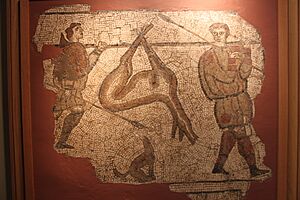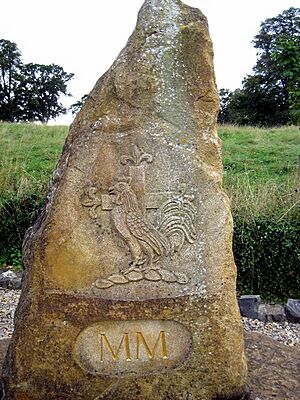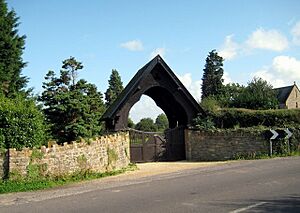East Coker facts for kids
Quick facts for kids East Coker |
|
|---|---|
 St Michael and All Angels' Church, East Coker |
|
| Population | 1,667 (2011) |
| OS grid reference | ST545125 |
| District | |
| Shire county | |
| Region | |
| Country | England |
| Sovereign state | United Kingdom |
| Post town | YEOVIL |
| Postcode district | BA22 |
| Dialling code | 01935 |
| Police | Avon and Somerset |
| Fire | Devon and Somerset |
| Ambulance | South Western |
| EU Parliament | South West England |
| UK Parliament |
|
East Coker is a lovely village and a special local area called a civil parish in Somerset, England. It's part of the South Somerset district. The closest big town is Yeovil, which is about 2 miles (3.2 km) north. In 2011, about 1,667 people lived here.
East Coker also includes smaller areas and hamlets like North Coker, Burton, Holywell, Coker Marsh, Darvole, Nash, and Keyford.
Contents
Village History

East Coker has a long and interesting history!
Roman Times
In the 1700s, people found the remains of a Roman villa here. A villa was like a large country house for wealthy Romans. Later digs found cool things, including a beautiful mosaic. A mosaic is a picture or pattern made from small pieces of colored stone or glass. More work is needed to fully understand the old Roman building.
Domesday Book
In 1086, a very old survey called the Domesday Survey was done in England. It recorded who owned land and what was on it. In this survey, East and West Coker were known simply as Cocre.
Manor of East Coker
For many years, the land and main house (called the manor) of East Coker were owned by different families. The Courtenay family owned it from 1306 to 1591. They built Coker Court, which was the main house for the manor. Later, a rich landowner named Edward Phelips bought it. After he passed away, the Helyar family took over and kept the manor for about 300 years. Today, a descendant of the Courtenay family is the current lord of the manor.
Plague and New Homes
In 1645, after the English Civil War, about 70 people in the village sadly died from the plague.
More recently, in 2011, there was a plan to build many new houses (about 3,700!) between East Coker and Yeovil. Many local people did not want this to happen. They even tried to get the area recognized as a World Heritage Site. This was because of its connection to a famous poet, T. S. Eliot. He visited the village and wrote a poem called East Coker in 1940. His ancestors came from the village.
How the Village is Run
East Coker has a parish council. This council helps with local issues.
Parish Council's Role
- They set a local tax to cover their costs.
- They check plans for new buildings in the area.
- They work with the police and local groups to keep the village safe and manage traffic.
- They help maintain and fix local facilities like footpaths and public transport.
- They also look after conservation (like protecting trees and old buildings) and environmental issues.
Local and County Councils
The village is part of the South Somerset district. This council handles things like:
- Approving building plans.
- Looking after local roads.
- Collecting rubbish and recycling.
- Managing parks and tourism.
Somerset County Council is in charge of bigger services. These include:
- Education for schools.
- Libraries.
- Main roads and public transport.
- Police and fire services.
- Waste disposal.
National Government
East Coker is also part of the Yeovil area for the Parliament of the United Kingdom. People in this area vote for one MP to represent them in the House of Commons in London.
Important Buildings
East Coker has several old and important buildings.
Coker Court
Coker Court was built in the 1400s as a manor house. Today, it's divided into several homes. Part of it was designed by a famous architect, Sir William Chambers, in the 1700s. It used to be a school called Clare School.
Other Historic Buildings
- Helyar Almshouses: These were built between 1640 and 1660. Almshouses were homes for poor or elderly people.
- Hymerford House: Also known as Grove Farmhouse, this building dates back to the 1400s.
- Naish Priory: This building is from the 1300s and was once an important part of the Coker manor.
Getting Around
East Coker does not have its own railway station anymore. The closest one is Yeovil Junction railway station. This station is on the train line that goes from Exeter to London Waterloo.
There are some bus routes that connect East Coker to nearby towns like Yeovil and Dorchester. Some of these services are "demand responsive," meaning you can book them to pick you up at a convenient time. There's even a night bus service on certain evenings!
Religious Sites
The church of St Michael in East Coker is very old, dating back to the 1100s. It's a special historic building. The ashes of the famous poet T. S. Eliot are buried here, as his family came from the village.
Famous People from East Coker
Several notable people have lived in or had connections to East Coker:
- William Dampier (1651-1715): A buccaneer, sea captain, explorer, and writer.
- Gerald Basil Edwards (1899–1976): An author from Guernsey.
- James Bree (1923–2008): An actor.
- David Foot (1929–2021): A British journalist and historian.
- Trevor Peacock (1931–2021): An actor famous for playing Jim Trott in the TV show The Vicar of Dibley.
- Marcus Fysh (born 1970): A politician and former Member of Parliament for Yeovil. He lives in Naish Priory.
Images for kids





